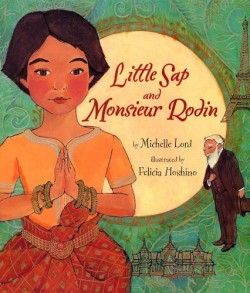It looks like you've stumbled upon a page meant to be read by our code instead of viewed directly. You're probably looking for this page.
Little Sap and Monsieur Rodin
In 1906 the king of Cambodia took forty-two dancers to perform at an exhibition in France. While there, the French artist Auguste Rodin is captivated by the engaging dancers and asks the king for permission to sketch three of the young girls. The encounter resulted in his acclaimed “Danseuse Cambodgienne” sketches. This real-life event inspired this historical fiction, which recounts the back-story of one of Rodin’s model dancers, named “Sap.”
Sap longs to be in the coveted royal dance troupe to help her family, who will gain status in their village if she is chosen. She is surprised and pleased when the princess invites her to dance. Over time, the scared, insecure girl is transformed into a graceful dancer who embarks on a wondrous journey to France, where she meets Rodin.
Throughout, it is apparent that the author has an emotional tie to Cambodia. She not only visited the country, but adopted a Cambodian child. She extensively researched the ancient Cambodian dance as well as the bearded Rodin before writing this, her first picture book. She intertwines fiction with actual quotes from the encounter between Sap and the artist.
Lord’s prose reflects the beautiful dance that Sap worked so hard to perfect, and captures the gentle spirit of the young dancer and her people. “She bent her hands like the fronds of a sugar palm curving toward the ground,” writes Lord, who also gives the reader glimpses into the Cambodian culture with her descriptive prose: “Some days were smooth and the ship rocked soothingly like the hammock of Sap’s babyhood.”
The reader also sees Sap long for the love and acceptance of the family she left behind even while dancing for Rodin: “Sap tried to concentrate. She opened her arms and spread her fingers like a blooming lotus. The gentle scritch scratch of Rodin’s pencil reminded Sap of the chickens scratching in the dirt back home. The thought comforted her.”
The illustrator is also making her picture book debut. She, too, researched Cambodian dance and through her art readers see the silk dance pantaloons, the hand motion for fruit and flower, and the dance pose that asks the gods for peace and happiness.
What is especially helpful is Lord’s inclusion of a brief history of Cambodia in the foreword and her author’s note with further information about the life of Rodin. An added treat is the black-and-white photograph of the real Rodin sketching one of the dancers in Marseille. A portion of the royalties from the books will be donated to Cambodian art and education.
Young readers will not only enjoy the story about a brave and beautiful dancer who must leave her family, but will also get a feel for an ancient Eastern culture often not delved into in American picture books.
Reviewed by
Cymbre Foster
Disclosure: This article is not an endorsement, but a review. The publisher of this book provided free copies of the book to have their book reviewed by a professional reviewer. No fee was paid by the publisher for this review. Foreword Reviews only recommends books that we love. Foreword Magazine, Inc. is disclosing this in accordance with the Federal Trade Commission’s 16 CFR, Part 255.
